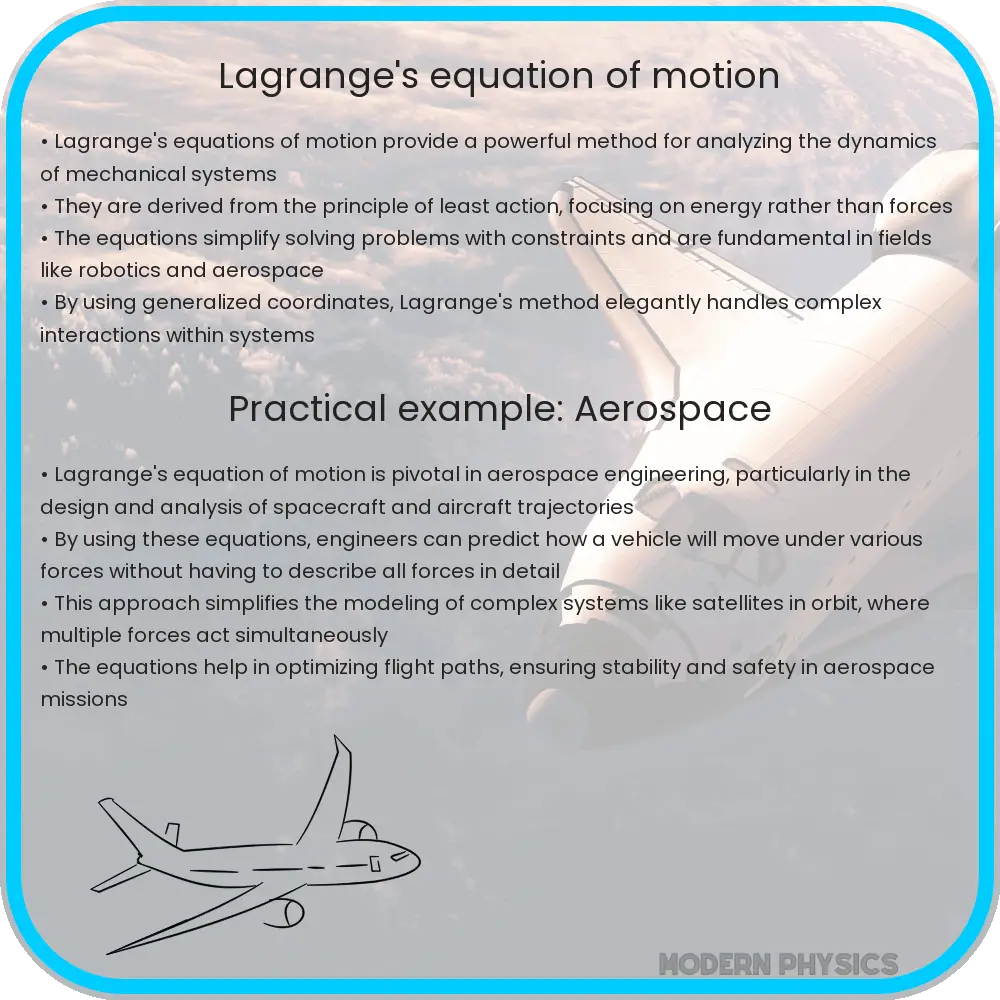Explore the essentials of Lagrange’s Equation of Motion in dynamics and mechanics, its applications, advantages, and modern computational techniques.

Understanding Lagrange’s Equation of Motion in Dynamics and Mechanics
The study of dynamics and mechanics often involves understanding the motion of objects and systems. A crucial aspect of this study is Lagrange’s Equation of Motion, a powerful tool in the analysis of mechanical systems. Developed by Joseph-Louis Lagrange, this equation provides a sophisticated method for deriving the equations of motion for a system, applicable to both conservative and non-conservative systems.
Basics of Lagrange’s Equation
Lagrange’s Equation of Motion is rooted in the principle of least action, a fundamental concept in physics stating that a system evolves between two instants of time such that the action is minimized. In simple terms, it provides a way to find the path that a system will follow based on the principle of least effort or least energy expenditure.
The equation is given by:
\[ \frac{d}{dt} \left( \frac{\partial L}{\partial \dot{q}_i} \right) – \frac{\partial L}{\partial q_i} = 0 \]
where \( L \) is the Lagrangian of the system, \( q_i \) represents the generalized coordinates, and \( \dot{q}_i \) are the generalized velocities.
Lagrangian Mechanics and Its Significance
Lagrangian mechanics, the framework in which Lagrange’s Equation is used, is an elegant reformulation of classical mechanics. It introduces the concept of the Lagrangian, \( L \), defined as the difference between the kinetic energy (\( T \)) and potential energy (\( U \)) of the system:
\[ L = T – U \]
This formulation allows for the analysis of complex systems where Newton’s laws might be difficult to apply, such as systems with constraints or non-inertial reference frames.
Applications of Lagrange’s Equation
Lagrange’s Equation of Motion finds applications across various fields in physics and engineering. It is particularly useful in the study of celestial mechanics, where it helps to explain the motion of planets and satellites. In engineering, it is used in the design and analysis of mechanical systems like robotics, vehicle dynamics, and structural analysis.
The power of Lagrange’s Equation lies in its ability to simplify complex systems into manageable equations, making it a cornerstone in the field of dynamics and mechanics.
Advantages and Challenges of Using Lagrange’s Equation
One of the key advantages of using Lagrange’s Equation of Motion is its ability to handle complex and constrained systems. Unlike Newtonian mechanics, which can become cumbersome in dealing with constraints, Lagrange’s formulation elegantly incorporates constraints through generalized coordinates. This makes it particularly advantageous in systems where the relationship between forces and motion is not straightforward.
However, there are challenges in applying Lagrange’s Equation. The formulation requires a deep understanding of the system’s energy properties and the ability to accurately define the kinetic and potential energies. In complex systems, determining these energies can be a non-trivial task, requiring careful analysis and sometimes approximations.
Extension to Non-conservative Forces
An important extension of Lagrange’s Equation involves the inclusion of non-conservative forces like friction or air resistance. In such cases, the equation is modified to:
\[ \frac{d}{dt} \left( \frac{\partial L}{\partial \dot{q}_i} \right) – \frac{\partial L}{\partial q_i} = Q_i \]
where \( Q_i \) represents the generalized forces. This modification expands the applicability of Lagrange’s Equation to a broader range of real-world scenarios where non-conservative forces play a significant role.
Modern Applications and Computational Techniques
In the modern era, Lagrange’s Equation of Motion is not just a theoretical construct but has practical applications in areas such as aerospace engineering, biomechanics, and robotics. The advent of powerful computational tools has enabled the simulation and analysis of systems governed by Lagrange’s equations with high precision, further extending its utility.
Conclusion
Lagrange’s Equation of Motion stands as a fundamental principle in the realm of dynamics and mechanics. Its versatile framework provides a robust tool for analyzing a wide range of mechanical systems, from simple pendulums to complex robotic mechanisms. While it requires a solid understanding of the system’s energy dynamics, its ability to elegantly incorporate constraints and non-conservative forces makes it indispensable in both theoretical and practical applications. As we continue to develop advanced computational methods, the relevance and application of Lagrange’s Equation are only set to increase, highlighting its enduring importance in the field of physics and engineering.
